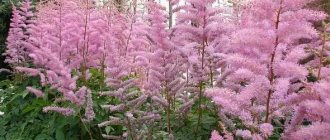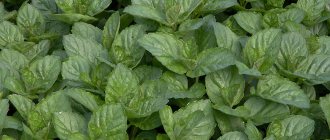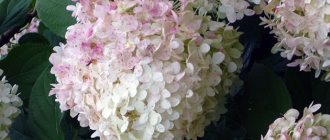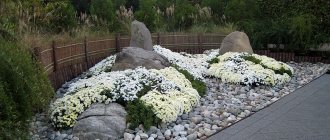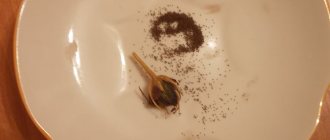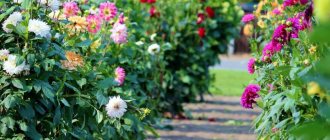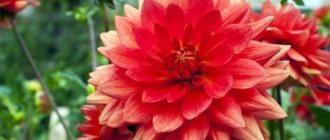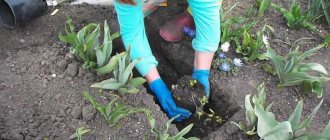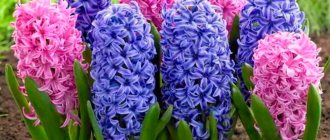Today, about 1000 species of ficus are known to science, but only some varieties are suitable for home cultivation. Individual varieties of ficus with photos and names will be presented in this article - they are most often used for home maintenance. This evergreen representative of the mulberry family appeals to many gardeners. Decorative deciduous ficus trees are easy to care for; you just need to follow certain conventions regarding a particular species. Due to their low maintenance requirements, along with their visual appeal, ficus trees decorate the interior of a living space, the atmosphere of any office, shopping center or cafe.
Rubber Melanie
All representatives of this family have a well-developed root system, the leaves have a dense structure, bright green color (certain varieties may have spots or edges), and different shapes.
The plant can be decorated as an indoor tree, a cascading hanging form, or a miniature bonsai. The natural growing environment allows them to reach enormous sizes and become full-fledged trees. Domesticated representatives of the ficus family have dimensions acceptable for the premises and grow slowly.
Ficus - where does it grow and where is its homeland? He prefers tropical countries, the coasts of the Pacific and Indian oceans, the Mediterranean, and South Africa. It is also common in Crimea, the South Caucasus, Central Asia, China, and India. The tropical rainforests of Malaysia and the Philippines, where ficus trees grow and bear fruit, are the plant’s homeland.
Ficus Binnendijka
Another variety that is easy to recognize by its appearance - thin (up to 40 mm), long (25-30 cm) leaves, aerial roots, and a light trunk. Due to its unusual foliage, it is sometimes confused with nolina, but ficus has a thin trunk. The crown is often dark green (Ali, Amstel King), but there are also variegated varieties (Amstel Gold).
The Benedikta variety does not like bright sun and prefers to grow in partial shade. Water it only after the top layer has dried - this way you will never flood the plant or damage it.
Petiolaris
One of the most beautiful varieties of ficus. It is distinguished by a fairly thick trunk and burgundy-red veins on the leaves. In winter, the leaves turn pale and the veins take on a soft pink hue.
This is a very rare species that is not easy to find on sale. You can admire the beauty of Petiolaris in the botanical gardens. However, if you get a chance to get such beauty home, do not refuse - like most ficuses, Petiolaris is quite unpretentious in care.
Ficus bengal
The variety's second name, banyan, comes from its unusual life form in the wild. The tree forms aerial roots, which take root as they go down, and over time become woody and turn into additional trunks. In this way, the tree can “step” to the side, expanding the diameter of its crown and forming a whole grove from one single plant.
In the wild it grows up to 30-40 m in height and up to 400 (!) in width.
At room conditions f. benghalensis is not so large - 2-3 m. Outwardly it resembles rubber and lyrata at the same time.
Auriculate
An exotic plant native to India and Southeast Asia. It has incredibly large leaves that resemble elephant ears. Thanks to their unusual structure, this ficus got its name. Interestingly, the young leaves of the auricular ficus have a reddish tint - and begin to turn green only with time.
Due to its very impressive size, this variety of ficus is not very suitable for breeding at home. But they can perfectly decorate an office, a hall or a personal plot.
Ficus Ginseng
Perhaps one of the most decorative species is ginseng or microcarpa. Among flower lovers it has the “underground” name of bonsai, because... the bizarre curved trunk resembles this variant of plant formation. The lower part of the stem is bare, on top there is a dense crown of dense glossy leaves.
For successful cultivation of f. ginseng microcarpa requires a semi-shaded place without drafts. If a flower blows, it can shed all its leaves and lose its decorative effect.
Rare varieties
Ficus in the interior of an apartment
If you can successfully grow popular species, it means that the climate in the house is suitable for exotics and you can plant other varieties of ficus, which are less common in indoor floriculture. Most of them are demanding in terms of care, humidity level and air temperature, but their decorative qualities are worth the effort.
Among the rare varieties:
- Microcarpa is a specimen with a bottle root protruding from the ground and a powerful lignified trunk. The foliage is dense green and responds well to pruning. Suitable for creating bonsai. Provided there is high humidity and diffuse lighting, it will delight you with the flower that forms in the axils of the leaves.
- Reed - requires regular feeding during the active growing season. The leaves look like tongues, the surface is glossy. The twigs and shoots are woody.
- Krishna is a very unusual variety found in the tropics of Africa. At the ends of the green shoots, a large green leaf with veins is formed, folded into a funnel. An ancient legend says that Krishna himself drank dew from these “glasses.” The trunk of the plant has a silver coating.
- Boxwood - the crown consists of small glossy fleshy leaves covered with natural wax. Does not take root well in stuffy rooms, requires high humidity and a temperature of at least 25 degrees. The trunk is powerful and woody. With regular pruning, a bonsai is formed.
Experienced gardeners manage to grow Ficus carica or figs at home.
Ripe fruits of ficus "Karika"
The plant requires special care; after shedding its leaves, it is removed to a cool place until new shoots appear.
Maintaining the temperature regime is the main condition that promotes flowering and fruit formation.
This is a variety with large leaves and a powerful root system. The tree requires space. Whatever variety of ficus variety you grow, the tropical plant will become a spectacular decoration of the space.
Review of ficus varieties and care secrets. Video
Ficus Retuza
Another “natural bonsai”, reminiscent of the previous variety. But unlike microcarp with almost round leaves, f. retusa leaves are thinner, pointed (in shape they resemble the foliage of Benjamin). But the trunk is just as non-standard - thick, curved, and beautiful in its own way.
The flower is grown in well-lit places; it requires frequent watering and, if possible, spraying or maintaining high humidity.
How to water
— Watering should be moderate and at the same time plentiful. Do not allow the soil to dry out or become too wet. In summer, watering should be moderate. Water for irrigation should be soft and settled. In winter, we reduce watering.
- Feeding. It is carried out together with watering in spring and summer. From March to September we fertilize twice a month. We use liquid mineral fertilizers that can be diluted in water for irrigation.
Ficus carica
One of the few varieties that have edible fruits. The second name of the species is known to everyone - fig! Indeed, “figs” grow on the stems of ficus - delicious fruits that can be eaten.
In appearance f. carica resembles a tall tree on a thin trunk with a lush crown. The leaves are large, the shape is broad-bladed, palmately notched (similar to grape leaves). Unlike its counterparts, carica is not so thermophilic - it does not tolerate heat well, growing best at temperatures up to 20 degrees. It is also better to protect from direct sunlight.
Where to put it.
Almost all ficus trees respond favorably to lighting; many can tolerate indoor growing conditions. For variegated forms and ficuses with bright foliage, more light is needed.
— Lighting . It should be bright, but without direct sunlight. If necessary, additional lighting can be used.
— The temperature for ficuses is identical to room temperature. The main thing is that in winter it does not fall below 10 degrees. Almost all ficus trees tolerate room temperature well. Avoid drafts and sudden temperature changes.
- Humidity . Ficus plants respond well to spraying. This will refresh the plant and remove dust from the leaves. If necessary, the humidity in the room can be improved using a humidifier or using a tray filled with expanded clay and filled with moisture.
Ficus deltoid
The name describes the appearance: leaves in the shape of soft triangles resemble the spelling of the letter “delta”. The plates are medium-sized (5-8 cm in length and width), dense. Most often they are monochromatic, but there are also variegated subspecies. On the branches of young f. deltoidea, you can see small fruits - they are inedible, but give the plant a special, recognizable appearance.
For successful cultivation, the deltoid ficus is placed in a bright place away from radiators (during the heating season). The flower should be watered and sprayed generously.
How to care
Almost any type of ficus can be considered an unpretentious indoor plant. The main thing is to follow certain growing rules and features in the care of certain species.
- The soil. the soil should be nutritious and well drained. For better aeration and to prevent acidification, you can add perlite or vermiculite to it. Universal soil is suitable, or you can purchase special soil for growing ficus.
- Landing. produced immediately after you bought the plant. We plant at the same height and depth as the plant grew in the planting pot. We do not deepen the root system too much. Be sure to place a layer of expanded clay or any other material at the bottom of the pot to create drainage. Excess moisture can lead to root rot.
- Transfer. Frequent replanting is not recommended for ficus trees. They are very sensitive and can shed leaves. Therefore, we carry out transplantation as needed. The main reason for replanting a plant may be to fill the pot with roots. This is when the roots have nowhere else to grow. The pot becomes too small for the root system and the plant begins to wither. We transplant the ficus trees into slightly larger pots.
Ficus Sacred
The third bonsai on the list grows like a banyan tree in the wild. However, in indoor conditions it is distinguished by its small size, as well as a decorative trunk of an unusual shape. The leaves are triangular, with elongated tips. Color - green, light yellow veins are clearly visible.
Unpretentious f. religiosa is undemanding to soil and will grow well at temperatures above 15 degrees and regular watering.
“Binnendiya Ali” (willow leaf)
This ficus received its name in honor of the man who first discovered this amazing plant - Simon Benedict. This ficus is quite popular and has already managed to win the hearts of thousands of Russian plant growers. Ficus Benedict, as it is also called, is quite unpretentious in care - and therefore especially loved by those who are not used to spending too much time caring for indoor flowers.
Binnendiya Ali is quite different from other varieties of ficus. What makes it especially beautiful are the unusually shaped leaves - narrow and pointed at the tips. The color of the ficus can be either monochromatic or variegated, depending on the variety.
Ficus rustifolia
In appearance f. rubiginosa can easily be confused with the variegated rubber plant, but the rustleaf ficus is smaller in size and has shorter leaves. The color is variegated, the cores and tips of the leaves are burgundy. The variety is more lush and bushy.
Grows well in well-lit places, in conditions of constant high humidity. It should be understood that the lighter the place of growth, the more decorative the leaves of the flower will be.
How to propagate.
- Reproduction. The main type of propagation of most ficuses is cuttings. To do this, you need to cut off part of the shoot and root it in a separate container. Some types of ficus can be propagated by leaves - but this is a rather labor-intensive process. Ampelous forms - can be propagated by layering or suckers, part of the shoot can be rooted. more details here.
Ficus montana
Let's return to creeping flowers: if the previous 2 (pumila, ivy) were similar to each other at least in small size, then f. montana is a completely different matter. Its leaves are quite large (~8*4 cm), elongated oval in shape. Since the branches fall down, it is grown as a hanging plant.
The lighter and warmer the room, the faster the mountain variety will grow. And vice versa - in dark, cool corners the flower may stop growing altogether.
Indian laurel
Native to Asia and Australia, Ficus microcarpa is classified as a ficus tree. Planted as an open ficus, Indian Laurel should grow in subtropical and tropical climates. This type can be pruned, used as an ornamental tree, or to form an extensive crown that provides shade in gardens.
Because Indian Laurel requires a warm, moist environment, Microcarpa varieties are popular as houseplants. Indian Laurel has also become a popular type of miniature tree in bonsai art.
Ficus Palmera
Another species suitable for growing in bonsai form: the root system is shallow, so the flower can grow in a shallow container typically used for bonsai. The trunk expands as needed - the plant uses it to store water during the dry season.
The leaves of f. palmeri are light green, heart-shaped, with pronounced light veins. In wild plants the size of the plates reaches 15 cm in length and width; in indoor dwarf trees they are usually smaller.
Anomani (crater-leaved)
It is often called forest ficus. In nature, this plant can be found in the forests of South Africa, Uganda, Zambia and Angola.
The leaves of the ficus Anomani are very unusual - cup-shaped, with a pointed tip. The shade of the leaf blade is bright, rich green. The surface of the leaves is smooth, leathery, with a characteristic glossy sheen.
The crater-leaved ficus is quite unpretentious in care and is perhaps the best choice for a novice plant grower.
Ficus Chereshkovy
An amazing variety that can look completely different: in dry areas it expands the lower part of the trunk to store life-giving moisture. In wet conditions it is a tree on a thin elongated stem. Combines both options into one - dark green heart-shaped leaf plates with red veins.
When growing in houses and apartments, please note that f. petiolaris does not like drafts, direct exposure to ultraviolet radiation and dry air. In addition, the flower sheds its leaves by winter - there is no need to be afraid of this; in the spring, the sessile ficus will grow again.
Aspera
Aspera is an evergreen tree. With good care, Aspera can grow up to 1 meter in height.
The main advantage of this ficus is its leaves. They are quite large, slightly rough to the touch. Their interesting coloring interspersed with white, dark green and light green colors resembles a marble pattern.
Ficus Aspera is quite expensive and quite capricious to care for, but such unsurpassed beauty must certainly require sacrifice.
Ficus Arrowhead
Finally, the fourth creeping variety - f. sagitatta gets its name from its long, sharp, arrow-shaped leaves. A monochromatic plant looks aesthetically pleasing, but the variegated subspecies looks more impressive.
Grow on shelves, furniture tops and in hanging baskets. As it grows, the sagitatta will lower its branches, and if you provide it with hooks, it will crawl along a wall or other surface.
Ficus plants are amazing plants! They can be large or small-leaved, grow in the form of trees or shrubs, and have slender or swollen trunks. Even if you have only unpretentious ficus trees in your apartment, you can achieve variety in your “indoor landscape.”
Elastica (rubber)
Perhaps the most famous variety of ficus. Even if you are not at all interested in indoor plants, you have probably seen the rubber-bearing ficus somewhere - it is incredibly common, and is a huge success among those who want to green up their apartment.
There is a belief that this particular type of ficus brings family happiness. Whether you believe in omens or not is up to you to decide - but the beauty of this ficus lies not only in its mystical meaning.
Rubber-bearing ficus has many varieties. As a rule, they are bred artificially to make the plant more compact.
Interior ideas: display flowers in a pot with drawings
Large varieties will take their place in corridors, balconies and offices. Rubber-bearing subspecies are especially popular in this regard. Ficus Ali can be grown outside in good weather conditions.
If you give the ficus freedom, it will grow in all directions, taking up the available free space. This can be used to create green walls or zoning a room. Flowers in decorative pots can cover the remaining free corner or repair problems
Decorative ficus trees can either decorate your desktop or become an addition to the greenhouse on the windowsill. Some varieties of dwarf trees are suitable for growing a bonsai analogue.
5/5 — (1 vote)
